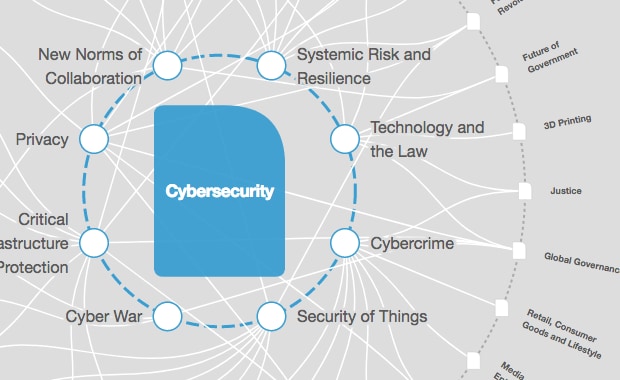These will be the main cybersecurity trends in 2020

5G will change the world - but will it make us more vulnerable, too? Image: REUTERS/Mike Blake

Get involved with our crowdsourced digital platform to deliver impact at scale
Stay up to date:
Cybersecurity
- The east-west 'cyber cold war' is set to intensify
- 5G and the IoT could make us all more vulnerable to cyberattack
- Businesses will start to rethink their approach to the cloud
The world is more connected than ever. We are becoming more technologically advanced, markets are stronger, and central technologies that encompass our daily actions are constantly emerging.
These technological advances are based on seamless connectivity. As our digital transformation continues, we continue to build a more cohesive and connected society. Our data is now shared and used by more platforms than ever – in the datacentre, on the cloud and event on internet of things (IoT) devices, for example - and this trend will only increase. But this huge benefit comes with a cost. The more connected we become, the more vulnerable our data is.
By looking at security developments over the past couple of years, it is possible to forecast what is likely to happen in the cyber landscape over the next 12 months. Forewarned is forearmed. These are what I believe will be the main trends of cybersecurity in 2020:
A new cyber 'cold war' is taking place online as Western and Eastern powers increasingly separate their technologies and intelligence. The ongoing trade feud between the US and China, and the decoupling of these two huge economies, is a clear sign. Cyberattacks will increasingly be used as proxy conflicts between smaller countries, funded and enabled by larger nations looking to consolidate and extend their respective spheres of influence.
Furthermore, utilities and critical infrastructures continue to be a target of cyberattacks, as seen in attacks on US and South African utility companies this year. Nations will need to consider dramatically strengthening cyber defenses around their critical infrastructure.
How is the Forum tackling global cybersecurity challenges?
The US elections in 2016 saw the beginning of AI-based propagation of fake news. Political campaigns devoted resources to creating special teams that orchestrated and spread false stories to undermine their opponents. As we prepare for major elections worldwide in 2020, we can expect to see these activities in full effect once again.
As AI continues to be used as a proxy for crime, it will also be used to accelerate security responses. Most security solutions are based on detection engines built on human-made logic, but keeping this up-to-date against the latest threats and across new technologies and devices is impossible to do manually. AI dramatically accelerates the identification of new threats and responses to them, helping to block attacks before they can spread widely. However, cybercriminals are also starting to take advantage of the same techniques to help them probe networks, find vulnerabilities and develop more evasive malware.
The notion that connectivity creates new combat landscapes is proven by the developing spheres of today’s and tomorrow’s cyberattacks. In the first half of 2019 we saw a 50% increase in mobile banking malware compared with last year, which means that our payment data, credentials and funds are handed over to cyberattackers in the innocent click of a button on our mobile devices. The attempts of cybercriminals to trick consumers to hand out their personal data through their most common means of communications will intensify and will range from email to SMS texting attacks, social media posts and gaming platforms. Whatever we use most frequently can become a more popular attack surface.
As 5G networks roll out, the use of connected IoT devices will accelerate dramatically, massively increasing networks’ vulnerability to large scale, multi-vector 5th generation cyberattacks. IoT devices and their connections to networks and clouds are still a weak link in security. This ever-growing volume of personal data will need securing against breaches and theft. We need a more holistic approach to IoT security, combining traditional and new controls to protect these ever-growing networks across all industry and business sectors.
Detection is no longer enough to ensure protection, and prevention is now the key to being secure.
Organizations already run a majority of their workloads in the cloud, but the level of understanding about security in the cloud remains low; in fact it is often an afterthought in cloud deployments. Security solutions need to evolve to new, flexible, cloud-based architectures that deliver scalable protection at speed.
Hardly a day goes by without a breach or cyber incident being reported. Attacks have become so damaging that the FBI has softened its stance on paying ransoms: the agency now acknowledges that in some cases, businesses may need to consider paying to protect shareholders, employees and customers. Through our ThreatCloud share intelligence technology we saw nearly 90 billion compromise attempts per day – compared with an estimated 6 billion daily searches on Google. These are new records which constantly being broken as time goes on, which means that the scope of victims is getting broader.
Understanding what is coming towards us will help us to better prepare. Some paradigms will need to shift. The enormous spread of technologies and solutions will force all of us to think about how to consolidate. In 2020 more than ever, cyberattacks are no longer a question of if, but of how and when. This is a concern that applies to us all.
Don't miss any update on this topic
Create a free account and access your personalized content collection with our latest publications and analyses.
License and Republishing
World Economic Forum articles may be republished in accordance with the Creative Commons Attribution-NonCommercial-NoDerivatives 4.0 International Public License, and in accordance with our Terms of Use.
The views expressed in this article are those of the author alone and not the World Economic Forum.
Related topics:
The Agenda Weekly
A weekly update of the most important issues driving the global agenda
You can unsubscribe at any time using the link in our emails. For more details, review our privacy policy.
More on CybersecuritySee all
Simon Torkington
April 23, 2024
Akshay Joshi
April 22, 2024
Spencer Feingold and Johnny Wood
April 10, 2024
Deryck Mitchelson
April 3, 2024
Akshay Joshi
March 21, 2024
Gayle Markovitz
March 1, 2024








